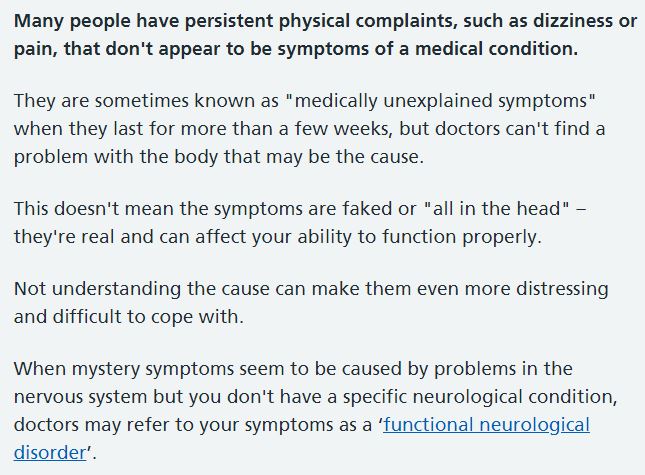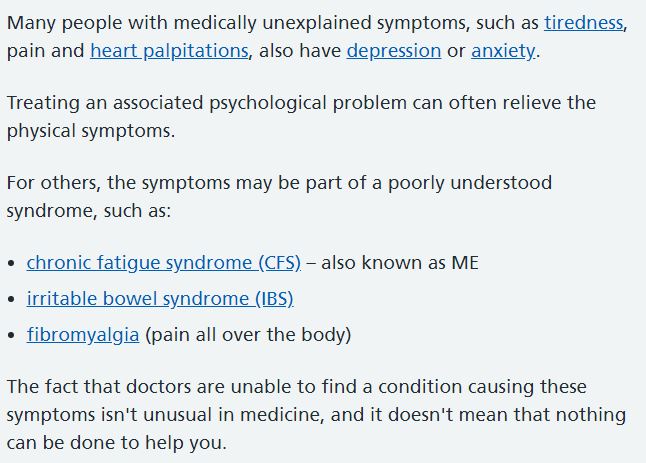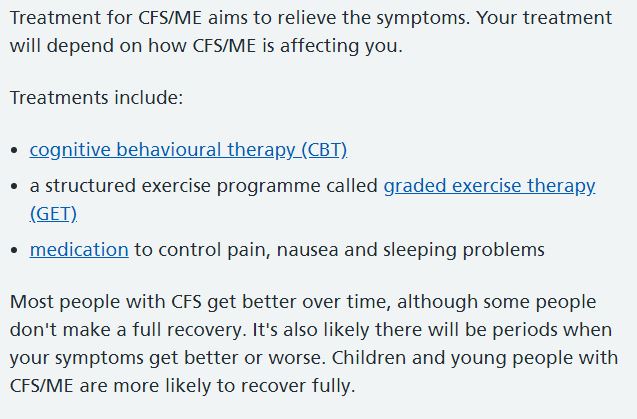The last time I blogged here back in May, close to the start of the pandemic crisis, I wrote about the pending reassessment of the ME/CFS NICE guidelines and suggested that the chance of the recommendation of graded exercise treatment being withdrawn was only slender. Truth to tell, I really had no idea what the outcome would be. I could equally well have been more optimistic. But given i) the apparent weighting of the guidelines development group towards those of a biopsychosocial disposition and ii) years of seeing no sign of improvement in the establishment view of ME/CFS in spite of the growing weight of evidence that such a viewpoint was wrong, I decided to take a more cautious stance, at least partly out of sheer habit.
Well, to judge from the present draft amended guidelines, I’m pleased to say it looks as though I was overly cautious. Though they are only draft guidelines and therefore still liable to change, it looks as though common sense has finally triumphed, and GET for ME/CFS, sustained for years on little more than its devotees’ Trump-like refusal to face the facts, is finally on its way out. Knowing what we do of its supporters, it is likely to go round the revolving doors for several years yet before it finally disappears, but that may not be the least of our worries. There is also the troublesome problem of what to put in its place.
Somewhere over the rainbow, they say, there is a glorious place called Never-Neverland, where wonderful things happen. This is a place where the biopsychosocial cabal didn’t steal away all the research funds for themselves, where the biomedical research which was actually needed got done, some treatments were found to improve our health, and my wife and I and many of you who are reading this have been able to gather together the strings of some kind of normal life again. And if long COVID had come along to such a place, then yes, we might have had some idea of what to do about it.
But Never-Neverland is not where we live of course. The stark reality of our own world is that many decades have been lost as time and money were squandered in pursuit of a psychiatrists’ pipe dream, and as a result, we are little nearer understanding what keeps our bodies stuck in a complex state of multi-systemic organic dysfunction.
‘Be aware there is no current treatment or cure (nonpharmacological or pharmacological) for ME/CFS’ the new draft guidelines announce gloomily in paragraph 1.11.1, the opening part of the section on Managing ME/CFS. In accordance with this, they confine themselves largely to advice on a management program which has at its heart the technique which patients call “pacing“, an attempt to make some kind of life for ourselves while staying within our limited range of energy, having to suffer a wide range of unpleasant symptoms on all those occasions we inevitably get it wrong.
Pacing is invaluable but it is not – as they put it – ‘curative’ and it’s hard on patients to be offered little else after so much time. We are paying, of course, for all those decades of inaction. What else could NICE come up with when there is so little evidence available?
Is it possible, though, that something is being missed?
My wife Chris, who some of you may know through various Facebook forums, became ill with ME in 1980 following a bout of glandular fever (aka Epstein Barr virus) from which she never really recovered. Some new readers might relate to this situation better if I describe this illness as ‘long Epstein Barr’, though in this case ‘long’ has so far extended to mean the rest of her life.
After several years of confusion about why she was not getting better, Chris was eventually diagnosed with ME by the late Professor Peter Behan, a neurologist who was carrying out important research into the condition (including an investigation of the HPA axis dysfunction) and who wrote the introduction to the late Professor Melvin Ramsey’s ground-breaking work on ME, ‘The Royal Free Disease’. Dr Charles Shepherd of the ME Association said of Professor Behan: ’unlike most of his neurology colleagues he had no doubt that ME was a serious neurological illness and that the patients were being badly let down by both clinicians and the research community.’
For most of the many years of ME which followed, Chris would have described her condition as either ‘moderate’ or ‘the severe end of moderate’, but a few years ago, in the spring of 2017, over the space of just a few months, she became ‘severe’. Her heart rate began to rise alarmingly, and stayed high even when she was lying down, to such an extent that she was no longer able to sleep. She became utterly exhausted, more so than ever before. This was partly due directly to shortage of sleep and partly due to the energy she was having to expend in maintaining her excessive heart rate. As far as her body was concerned, it was running a marathon all the time. It was far from an ideal state of affairs for anyone, let alone a person with long-standing ME. This was the most ill she had ever been in all those years.
She was referred to a cardiologist, who prescribed medication which lowered her heart rate, though the latter remained excessive when lying down. He was unable to suggest any reason for what had happened, but a Fitbit confirmed that Chris’ heart rate varied with her posture, so from what she could find on the internet, it seemed very likely that she had developed POTS. This is short for ‘postural orthostatic tachycardia syndrome’, which in turn is caused by ‘dysautonomia’, a dysfunction of the autonomic nervous system (ANS).
It may seem surprising that it was Chris rather than a doctor who came up with this solution, but in fact it isn’t. As it says on the website of the national patient support group, PoTS UK, ‘many healthcare professionals do not know that PoTS exists.’
Chris was able to find a cardiologist in a neighbouring health authority who took an interest in PoTS, however, and he was able to give her a diagnosis and further medication to improve her heart rate, so she was finally able to get a better night’s sleep. He also supplied the important information that many patients with PoTS also suffered with mast cell activation syndrome (MCAS), a little-known condition which is caused by the abnormal release of chemicals from within mast cells.
Mast cells are a normal part of our body’s immune system and these chemicals are normally released to help us fight infection. In MCAS, however, the chemicals are released inappropriately when the mast cells are stimulated, producing numerous inflammatory and immune symptoms. (Though MCAS is little known, there is another condition called mastocytosis, which is caused by too many mast cells in the body. This is better understood but is much less common than MCAS.)
Once again, Chris was lucky enough to find a consultant who took an interest in the condition, not exactly on our doorstop but within an accessible distance for travel. Chris had checked online and found that she had almost all of the symptoms of MCAS, so she was not surprised when the immunologist confirmed that she had the condition. Once again, she was given medication which helped the symptoms. Thinking back to the onset of the problem with her heart rate, it now seemed likely that this had been caused by MCAS: a histamine over-reaction to the high rape seed pollen levels there had been in the area at the time.
The PoTS UK site lists PoTS, MCAS, and also Ehlers-Danlos Syndrome (EDS/hypermobility spectrum disorder) as related conditions, and Chris has been told very recently by a rheumatologist that she is hyper-mobile, so she now has what her consultant has described as the ‘full house’ – although could it be that she should also add her long-standing diagnosis of ME to the same collection?
Chris is not alone in having ME plus one or more of these other conditions. The MCAS groups on Facebook are full of people who have been given a diagnosis of ME, while the PoTS groups on Facebook are full of people who have been given a diagnosis of MCAS and ME. In Chris’s case, taking two medications to help with her PoTS and three to help with her MCAS plus various supplements which also help MCAS has enabled her to achieve a quality of life which is better than that which she had three years ago before the sudden downturn. She counts herself particularly lucky to have been able to consult doctors who are so knowledgeable about PoTS and MCAS respectively. But from what she has heard on the Facebook groups, she knows that a great many other people with ME have also improved after being treated for these same co-morbid conditions. There must surely be other people who would also benefit if only they knew…
What exactly is going on here? How can we describe the relationship between ME and these other conditions? Are they indeed co-morbidities or is there in fact a closer relationship between them?
In March 2018, in Salt Lake City, a summit of doctors specialising in ME/CFS declared that ‘mast cell activation syndrome may be an overlooked yet potentially treatable contributor to the symptoms of ME/CFS’, and several attending doctors suggested that round about 50% of their ME/CFS patients had MCAS. Dr Susan Levine explained that if doctors could do something to help the mast cell problem, patients might be better able to tolerate drugs to treat ME/CFS.
Closer to home, the paediatrician Dr Nigel Speight, highly respected by patients in particular, recently contributed the following to a video on very severe ME/CFS: ‘more recently, we have become aware of a quite frightening condition called mast cell activation syndrome in which patients have severe reactions to foods to which they are intolerant based on histamine release… This is not a cardinal part of ME but it seems to be an added complication and it is responsive to treatment… so it’s very well worth knowing about.’ (From ‘A more detailed look at severe ME’ – ‘Dialogues for a Neglected Illness’ by Natalie Boulton and Josh Biggs – scroll down to the second video on the page, starts at about 9-00 in.)
‘Well worth knowing about’: those closing words from Dr Speight seem to sum the whole thing up. So shouldn’t mast cell activation at least be mentioned in the NICE Guidelines? As it stands, it doesn’t even appear. Neither does Ehlers Danlos Syndrome/Hypermobility. Of the three commonly encountered comorbidities featured in this post, only PoTS is mentioned in the draft guidelines (as one of the symptoms which is commonly experienced by the severely affected) – along with postural hypotension (ie reduced blood pressure but without the increased heart rate) which seems to affect the majority of people with ME. The draft guidelines also contain brief notes on the management of orthostatic intolerance.
Bearing in mind the remarks of Dr Speight and the other doctors quoted above, the total omission of any mention of MCAS from the proposed guidelines seems curious to say the least.
It is worth mentioning that there is a Royal College of GPs toolkit on Ehlers-Danlos Syndrome (produced in partnership with Ehlers Danlos Support UK) which includes a section on ‘Emerging Major Associations’ where the other related conditions are mentioned. It’s interesting to speculate if there will come a time when ME/CFS will also appear on that list.
For the time being, however, says Chris, it is too early to say how these various conditions might fit together. She hears all sorts of speculations online (is ME really MCAS?; is MCAS caused by ME etc?) but it seems to her that at the present time, there is too little to go on. What is really important, vital even, is that those with a diagnosis of severe or moderate ME who feel that they may have some or all of the symptoms of MCAS are able to see a doctor who understands the condition, who is able to examine them, and if necessary give them a diagnosis and prescribe medication to help their symptoms and improve their quality of life in the same way that Chris has been helped.
As the draft guidelines say, there is no current treatment or cure (nonpharmacological or pharmacological) for ME/CFS. There are however treatments for these co-morbid conditions. So it would be unfortunate if they continued to fall beneath the radar of, we suspect, a great many patients and doctors – and if the opportunity afforded by the revision of the guidelines to bring this to their attention was overlooked.
If you would like to know more:
- Here’s a very concise, accessible YouTube summary of MCAS by Dr Tina Peers, an expert GP who specialises in the condition. The video is aimed at people who have long COVID but it is just as applicable to those with ME.
- Additionally, the PoTS UK national patient support group has very good, concise info on PoTS plus the other associated conditions. Also worth looking at Mast Cell Action on MCAS.
- The best way to find a doctor is through the national patient support groups: PoTS UK and Mast Cell Action
- You may encounter some confusion about the ways in which MCAS and PoTS are diagnosed so I’ll share what I know here, though as you’ve probably guessed, I’m not medically qualified. MCAS: Doctors sometimes think a high serum tryptase test is used to diagnose MCAS but in fact this is a test for the more widely understood – but less common – mast cell complaint, mastocytosis. MCAS will usually give a normal tryptase result but that doesn’t mean you don’t have MCAS. Apparently the best way to diagnose MCAS is by symptomatology plus a positive response to medication. PoTS: Many people are deterred from seeking a PoTS diagnosis because of concern that they may have to undergo an arduous Tilt Table Test, but this should not be necessary. Chris’ doctor was aware that this test is unsuitable for people with ME and normally uses the Active Stand Test instead. Unfortunately, even this requires the patient to stand for ten minutes, but in Chris’ case she was diagnosed without any test at all due to the severity of her condition.





